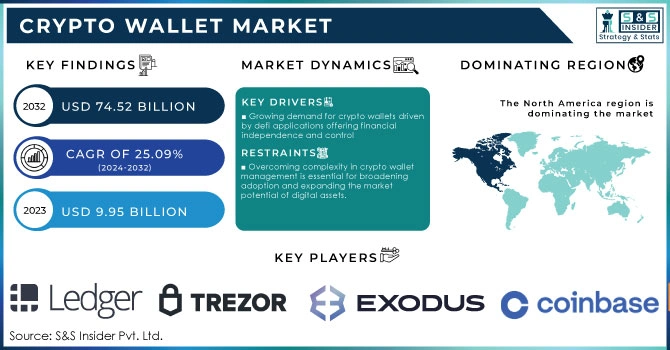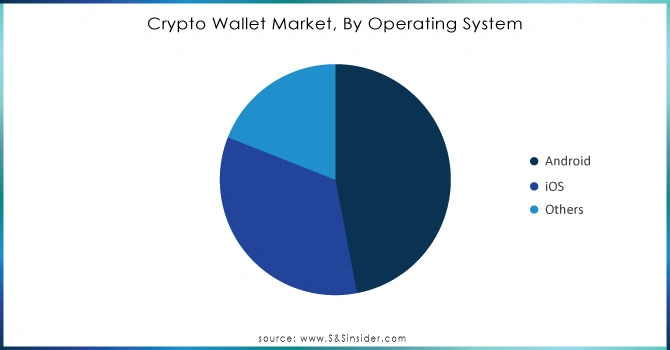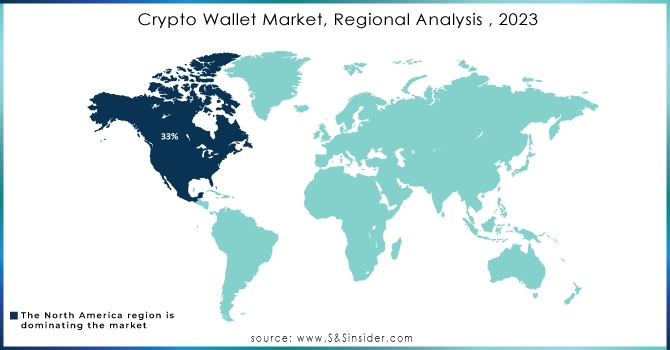Crypto Wallet Market Key Inisights:
The Crypto Wallet Market size was valued at USD 9.95 Billion in 2023 & It is estimated to reach USD 74.52 Billion by 2032, growing at a CAGR of 25.09% over the forecast period of 2024-2032.

To Get More Information on Crypto Wallet Market - Request Sample Report
The crypto wallet market has witnessed exponential growth in recent years, fueled by the rising adoption of cryptocurrencies and the need for secure, user-friendly solutions to store digital assets. In 2023, the crypto market showcased impressive expansion, driven largely by optimism around a potential U.S. spot Bitcoin ETF approval. By year-end, the total crypto market cap surged by 108.1%, growing from USD 829 billion to USD 1.72 trillion, while total trading volumes reached USD 36.6 trillion, reflecting a 53.1% increase in Q4 alone. Bitcoin, a staple asset in most wallets, saw a remarkable 155.2% increase from USD 26,918 to USD 42,220, fueled by ETF anticipation. Ethereum also gained traction, closing the year at USD 2,294 with a 90.5% growth, while Solana emerged as a top performer, skyrocketing by 917.3% to USD 101.3, due to renewed interest and its network's resilience, despite prior challenges tied to FTX. NFTs (Non-Fungible Tokens) also influenced the market, with the total trading volume across the top 10 chains reaching USD 11.8 billion, though down 44% from 2022. However, Bitcoin Ordinals trading spurred a Q4 rebound in NFT activity. Crypto wallets became essential tools for managing and securing these assets, enabling users to diversify holdings in key assets like Solana and Ethereum while participating in the expanding DeFi and NFT ecosystems.
The gaming industry represents another major sector driving the crypto wallet market. Blockchain-based games often use cryptocurrencies as in-game currency, allowing players to buy, sell, and trade virtual assets seamlessly. Crypto wallets enable gamers to securely store digital collectibles and manage in-game earnings, particularly as NFTs open new possibilities for gamers and creators. Here, crypto wallets are instrumental in the buying and selling of unique digital assets, enhancing the user experience and financial security in blockchain gaming.
Market Dynamics
Drivers
- Growing demand for crypto wallets driven by defi applications offering financial independence and control
DeFi apps provide financial services independently of centralized institutions, giving individuals options beyond conventional products such as loans, savings accounts, and insurance. Decentralized finance (DeFi) market revenue is expected to reach USD 26,170 million in 2024. For individuals to take part, a crypto wallet is indispensable in this decentralized system that heavily depends on blockchain technology. The demand for wallets that can interact with DeFi applications has increased as more users look for alternatives to traditional financial institutions. DeFi is attractive because it offers financial freedom, transparency, and autonomy, drawing a diverse user base that includes both tech-savvy individuals and those without access to traditional banks. Cryptocurrency wallets, particularly those that work with DeFi applications, allow users to handle their assets, exchange tokens, and participate in peer-to-peer lending. The increasing DeFi environment has led to the creation of wallets designed for certain platforms and protocols, which in turn boosts market growth as users seek out wallets that can easily connect with different DeFi platforms.
- Growing regulatory clarity worldwide boosts consumer confidence, institutional interest, and demand for secure, compliant crypto wallets.
The adoption of cryptocurrencies was hindered for a long time due to uncertainty surrounding regulatory issues. Still, there is a growing number of countries implementing specific regulations, alleviating worries for users and businesses alike. Regulatory structures are crucial for building confidence in cryptocurrencies, as they offer legal safeguards and set standards for market conduct. Governments worldwide are enacting legislation to stop money laundering, fraud, and other financial crimes associated with cryptocurrencies. For instance, in the U.S., businesses offering custodial crypto wallets, along with other money transmission services, are obligated to register as Money Services Businesses (MSBs) as mandated by the Financial Crimes Enforcement Network (FinCEN). This indicates that they are required to follow the regulations of the Bank Secrecy Act (BSA), which includes the enforcement of Anti-Money Laundering (AML) and Know Your Customer (KYC) protocols. Clear regulations also attract institutional involvement, by reducing the perceived risks of entering the cryptocurrency market. Wallets that can accommodate both institutional and retail clients will experience increased demand as banks and investment firms become more interested in crypto assets.
Restraints
- Overcoming complexity in crypto wallet management is essential for broadening adoption and expanding the market potential of digital assets.
Managing a crypto wallet requires a basic understanding of how blockchain technology works, which can be a barrier for many people. Concepts like private keys, public addresses, and seed phrases may be confusing, especially for users accustomed to traditional banking. The process of transferring digital assets between wallets can also be challenging, as mistakes could result in irreversible losses. Unlike traditional financial institutions, there is no customer support number to call in case of errors. This complexity creates a barrier to entry for less tech-savvy users, limiting the market’s potential growth. Although efforts are underway to simplify wallet interfaces, the inherent complexity of managing digital assets remains a significant restraint for the broader adoption of crypto wallets.
Market Segmentation
By Type
Hot wallets held a major market share of 58% in 2023, dominating the segment, because of their convenience, simple availability, and wide acceptance by everyday cryptocurrency users and traders. Hot wallets, being connected to the internet, are perfect for regular transactions and instant access to funds. Applications such as Coinbase Wallet and MetaMask enable users to purchase, trade, and store different cryptocurrencies directly from their mobile device or computer. Hot wallets are favored by users who value fast transactions and easy access, especially when trading on cryptocurrency exchanges. Nevertheless, being on the internet makes them more vulnerable to hacking, so strong security measures are needed to safeguard user funds.
Cold Wallets are gaining popularity with a rapid CAGR during 2024-2032, due to the rising understanding of the security risks linked to online wallets, making it a quickly expanding market segment. Cold wallets, in contrast to hot wallets, keep cryptocurrencies offline, reducing their susceptibility to cyber-attacks. This is attractive to investors who hold onto assets for a long time and institutions who value asset security more than instant access. Ledger and Trezor are examples of cold wallet apps that offer Hot Wallets wallets for securely storing private keys offline. Due to the increasing demand for cryptocurrency as a long-term investment, cold wallets are growing in popularity, despite being less convenient for daily transactions because of the steps needed to access funds.
By Operating System
The Android segment led the market in 2023 with a 47% market share in the crypto wallet market, largely due to Android’s global market share and accessibility across various device types and price ranges. The fact that it is open-source enables a variety of developers to design and personalize crypto wallet apps, which is attractive to users in developed and emerging markets. The extensive reach and adaptability of Android-based wallets have allowed them to attract a large number of users. For example, Trust Wallet and Exodus, renowned crypto wallets, utilize the Android ecosystem to offer users simple, secure, and diverse wallet options.
The iOS segment is emerging as the fastest-growing segment with a rapid CAGR during 2024-2032 in the crypto wallet market, primarily driven by Apple’s focus on security and user privacy, factors highly valued by cryptocurrency users. Apple's strong security measures such as Face ID and Touch ID are providing added security for iOS-based crypto wallets during transactions and storage. Examples of iOS crypto applications like Coinbase Wallet and Crypto.com Wallet provide users with a secure and user-friendly environment for managing digital assets.

Do You Need any Customization Research on Crypto Wallet Market - Inquire Now
Regional Analysis
North America dominated the market regionally with a 33% market share in 2023, due to its robust financial infrastructure, high adoption rates of digital assets, and supportive regulatory framework for cryptocurrency. North America has put itself at the forefront of crypto wallet usage due to numerous investors and companies adopting blockchain and crypto solutions. Prominent companies like Coinbase, a cryptocurrency exchange based in the United States, have created secure and easy-to-use wallets that are popular among American users for holding and exchanging digital assets. Moreover, North American traditional financial institutions are investigating crypto wallet services, incorporating crypto options into their platforms like Visa and PayPal, which enhances accessibility to a wider range of users.
Asia-Pacific is anticipated to become the fastest-growing region in the crypto wallet market during 2024-2032. Rapid adoption is being driven by a strong interest in digital currencies, digital finance initiatives led by the government, and a large number of tech-savvy users. For example, Binance, established in China, and BitPay, catering to clients in APAC, provide multi-currency wallets to meet the varied cryptocurrency requirements in the area. Furthermore, countries such as Japan have established specific rules for cryptocurrency, promoting creativity and drawing in applications based on digital currency. APAC's rapid expansion makes it a crucial region for the development of crypto wallets.

Key Players
The key players in the Crypto Wallet Market are:
-
Ledger (Ledger Nano X, Ledger Nano S Plus)
-
Trezor (Trezor Model T, Trezor Model One)
-
Exodus (Exodus Desktop Wallet, Exodus Mobile Wallet)
-
Coinbase Wallet (Coinbase Mobile Wallet, Coinbase Extension)
-
MyEtherWallet (MyEtherWallet Desktop, MyEtherWallet Mobile)
-
Trust Wallet (Trust Wallet Mobile App)
-
ZenGo (ZenGo Mobile Wallet)
-
KeepKey (KeepKey Hot Wallets Wallet)
-
Electrum (Electrum Desktop Wallet, Electrum Mobile Wallet)
-
Armory (Armory Bitcoin Wallet)
-
Coinomi (Coinomi Mobile/Desktop Wallet)
-
Enjin Wallet (Enjin Mobile Wallet)
-
Edge Wallet (Edge Mobile Wallet)
-
Mycelium (Mycelium Mobile Wallet)
Providers of software solutions for these wallet providers:
-
Ledger Live (Ledger)
-
Trezor Suite (Trezor)
-
Exodus Exchange (Exodus)
-
Coinbase Exchange (Coinbase)
-
MyEtherWallet Desktop (MyEtherWallet)
-
Trust Wallet Mobile App (Trust Wallet)
-
ZenGo Mobile Wallet (ZenGo)
-
KeepKey Hardware Wallet (KeepKey)
-
Electrum Desktop Wallet (Electrum)
-
Armory Bitcoin Wallet (Armory)
Recent Developments
-
October 2024: Kamala Harris's plan to implement a 25% tax on unrealized capital gains has caused a lot of concern in the cryptocurrency community, particularly among individuals who own assets worth more than USD 100 million.
-
October 2024: Crypto staking programs that provide daily rewards are becoming popular in the current cryptocurrency market as users look for stable investment options. In line with this movement, the Binance Web3 Wallet now includes 13 additional protocols in its Earn section, allowing users to earn rewards across a broader range of tokens and networks.
-
October 2024: Kraken Exchange expanded its offerings with the introduction of a new ETH re-staking feature through Eigenlayer, simplifying the procedure for users looking to enhance their DeFi participation.
| Report Attributes | Details |
|---|---|
| Market Size in 2023 | USD 9.95 Billion |
| Market Size by 2032 | USD 74.52 Billion |
| CAGR | CAGR of 25.09% From 2024 to 2032 |
| Base Year | 2023 |
| Forecast Period | 2024-2032 |
| Historical Data | 2020-2022 |
| Report Scope & Coverage | Market Size, Segments Analysis, Competitive Landscape, Regional Analysis, DROC & SWOT Analysis, Forecast Outlook |
| Key Segments | • By Type (Hot Wallets, Cold Wallets) • By Operating System (Android, iOS, Others) • By Application (Peer-to-Peer Payments, Trading, Remittance, Others) • By End-User (Individual, Commercial) |
| Regional Analysis/Coverage | North America (US, Canada, Mexico), Europe (Eastern Europe [Poland, Romania, Hungary, Turkey, Rest of Eastern Europe] Western Europe] Germany, France, UK, Italy, Spain, Netherlands, Switzerland, Austria, Rest of Western Europe]), Asia Pacific (China, India, Japan, South Korea, Vietnam, Singapore, Australia, Rest of Asia Pacific), Middle East & Africa (Middle East [UAE, Egypt, Saudi Arabia, Qatar, Rest of Middle East], Africa [Nigeria, South Africa, Rest of Africa], Latin America (Brazil, Argentina, Colombia, Rest of Latin America) |
| Company Profiles | Ledger, Trezor, Exodus, Coinbase Wallet, MyEtherWallet, Trust Wallet, ZenGo, KeepKey, Electrum, Armory, Coinomi, Enjin Wallet, Edge Wallet, Mycelium |
| Key Drivers | • Growing demand for crypto wallets driven by defi applications offering financial independence and control • Growing regulatory clarity worldwide boosts consumer confidence, institutional interest, and demand for secure, compliant crypto wallets. |
| RESTRAINTS | • Overcoming complexity in crypto wallet management is essential for broadening adoption and expanding the market potential of digital assets. |

